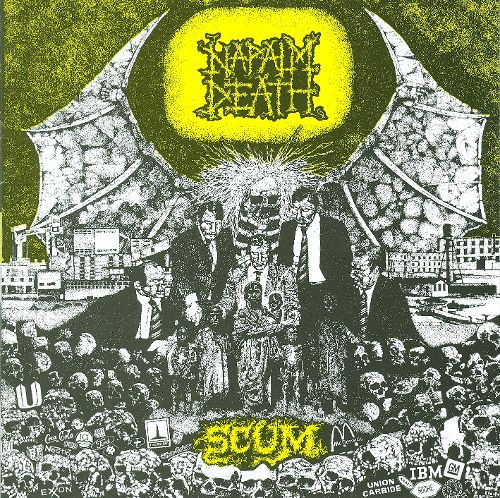
The extreme growth of grindcore
By Caroline Ho, Arts Editor
The term “extreme metal” refers to music that takes all the characteristics of metal and pushes them even further. Basically, it’s metal at its fastest, rawest, most abrasive, and noisiest. One of the extreme genres that is perhaps most noisy, abrasive, and fast is grindcore.
Grindcore emerged as the unholy union of hardcore punk and thrash metal, both of which blossomed as distinctive sounds sometime in the late 1970s. Thrash metal was distinguishable by its high-speed, aggressive, complex guitar riffs—think early Metallica. Hardcore punk was also rapid and angry, usually with vocals screaming about politics, social issues, and general antiestablishment rawness. Hardcore groups like Black Flag thrived and simmered with anarchic sentiment in underground scenes.
Go even faster and more intense, and that’s where grindcore came in. The most notable precursors of the genre were Siege, a hardcore outfit from Massachusetts, whose goal was to play as fast as humanly possible, and Michigan-based death metal group Repulsion, who released a handful of demos in the mid-’80s before their first and only album Horrified came out in 1989.
Grindcore coalesced as a genre with the band Napalm Death. Formed in Britain in 1981, they were first part of the anarcho-punk scene, then in the mid-’80s incorporated more aspects of thrash and the superfast drumming that would become the key characteristic of grindcore. Drummer Mick Harris is one of the people credited with coining the name, based on the blistering speeds of his percussion—though other sources suggest the name came from the harsh down-tuned “grinding” noise of the guitars. Whatever the precise origins, Napalm Death gained some moderate mainstream success in the late ’80s and early ’90s, releasing several albums, going on a few tours, and being featured in a few music magazines.
Other bands in the UK were influenced by Napalm Death, including Carcass, formed in 1985, and Extreme Noise Terror, the band Mick Harris joined in 1987. In the ’90s, the heart of grindcore shifted to the US, featuring bands like Terrorizer, Brutal Truth (which included the former bassist of thrash heavyweight Anthrax), Pig Destroyer, and more. Though never a phenomenally popular genre, it continues to grow in popularity with its fans.
The defining characteristic of grindcore is the “blast beat,” a super fast drum beat played in 16th or 32nd notes across the bass and snare drums. The result is a frenetic and distinctive blast-like pace. Initial usage of the term “blast beat” is again attributed to Napalm Death, although they weren’t the first to use the technique. Blast beats and variations of it, such as the gravity roll and bomb blast, are also found in other types of extreme metal.
Another feature of the grindcore genre is having exceptionally short songs or “microsongs,” a consequence of playing ridiculously fast. A lot of grindcore albums are only about 20 minutes long, as opposed to the usual 10 to 12-track, 40 to 45-minute LPs of most genres. Napalm Death currently holds the Guinness World Record for shortest song with their 1987 track “You Suffer,” at 1.316 seconds long. Supposedly the song’s lyrics are “You suffer/But why?” but it sounds more like a very brief “Rrraaaahh.”
The vocals of grindcore are usually death growls and high-pitched shrieks that are often deliberately unintelligible. Lyrics, if there are any at all, tend to be provocative in a variety of ways. Some artists and groups, in the vein of hardcore punk, tend to focus on sociopolitical themes of anarchism and anti-capitalism. Lyrical variation has also led to a few scion subgenres of grindcore by musicians who thought that grindcore had become too derivative of far-left themes. Goregrind, pioneered by Carcass, treats subject matter about blood, gore, forensic pathology, and death. Pornogrind, as its name suggests, focuses on sex and perversion.
Grindcore has also led to the development of subgenres that are stylistic rather than thematic offshoots, notably deathgrind, which blends the technical sophistication of death metal with the breakneck tempo of grindcore, and electrogrind, which incorporates electronic and industrial metal elements.
Grindcore certainly isn’t everyone’s cup of tea, but you can’t deny that it succeeds at what it sets out to do—to push metal to its absolute limits, making music as fast and noisy as physically possible.
